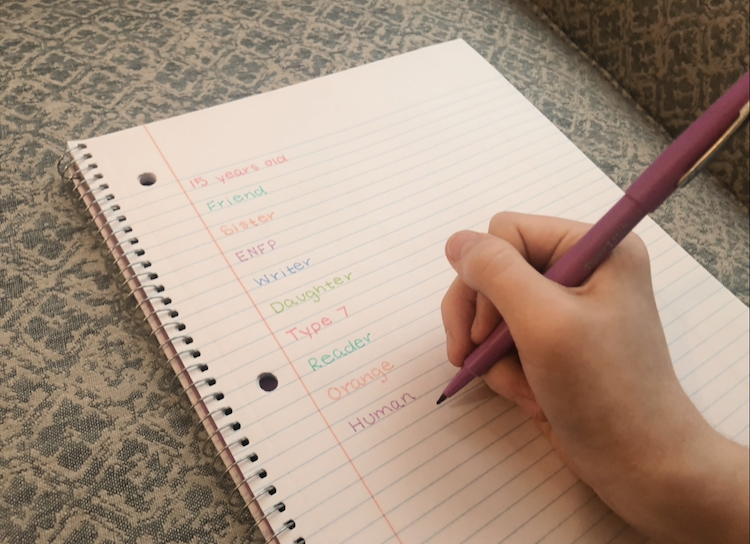Students may be overlooking an opportunity for exceptional self-awareness

More stories from Natalie Mix
This list represents a variety of defining qualities students may identify with, including personality types and simply being human
A classroom-full of students pause in the fluorescent glow of their laptop screens. The screen loads for a barely noticeable second, and in that moment, they are all waiting. Whether in apathy, expectancy, or avidity, they are all about to see a different result appear on their screen.
The screen loads, and they scroll down to read the paragraph that explains their results. Maybe it makes sense, maybe it doesn’t, maybe they’re not quite sure. But each of these students has just been told something about themselves.
And so it goes in Psychology teacher Brian Pierce’s classroom. While participating in a personality test may be an insignificant moment for some students, for others, it opens the door to a deeper understanding. It may even open the door to another world of discovery.
“Lots of times when my students get done with [a personality test], they can’t believe what they just read,” Pierce said. “They feel like themselves in the paragraph that they just read that’s supposedly about them.”
This moment of clarity can be one that students have not experienced before, as they acknowledge the validity of the results. They can find themselves in a simple paragraph; they might feel a sense of community in realizing that they are not alone.
“I think that students are just curious about who they are,” Pierce said. “Everybody’s personalities are different. There’s really no personality that’s exactly the same. And so I think they just like the uniqueness about it in finding out more about themselves.”
For some, it’s as far as they will go into this world of complex personality. For others, it’s merely the beginning of an ever-changing exploration. For sophomore Jena Detweiler, diving into the realm of personality tests was the start of a new hobby.
Having yet to participate in Pierce’s Psychology course, Jena was introduced to a variety of personality tests by her mom and her friend’s mom. While she’s traversed a few different tests, she has found the deepest level of connection in the Enneagram—a test with nine different types, each differentiated by a number.
However, in all of the tests she’s taken, Jena has struggled to wholly identify with one category. Considering the Enneagram, she’s torn between many types, primarily the Four and the Five. For a long time, she considered herself a Five—The Investigator: an intense, cerebral type. But in recent times, she has come to question it.
“I think a lot, and I’m very in my head,” Jena said. “However, I don’t have a lot of the Five tendencies. They talk a lot about researching things and do a lot of research up to something but never actually complete it, and I just don’t get that into stuff as much as Fives do. And I’m not as closed off, I think, as Fives are either.”
Once she began doubting her type, Jena also wondered if she was a Four—The Individualist: a sensitive, introspective type. While she is unsure if she’s as in touch with her emotions as a Four might be, she relates to the desire for individuality and a hatred for being just like everyone else.
“As a kid, I never wanted to wear things that I knew a lot of people were wearing,” Jena said. “I always shied away from that because I was like, ‘no, that’s so basic.’ And I’m still really doing that with pink; I don’t like pink, and it’s for kind of a crappy reason. I don’t want to do that because it’s the stereotypical girl thing.”
Jena and her friends have spent many lunch periods and hour delays mulling over these possibilities for her. It’s not uncommon to find them roping new people into their discussion and attempting to discover where these new people might fit into a category.
Between trying to find out where she might land and trying to guess at other people’s types, Jena isn’t ashamed to admit that she’s very intrigued by the Enneagram.
“I like typing other people,” Jena said. “It’s kind of a fun conversation topic with a lot of people; you can just get really into it, and for some reason, I enjoy trying to find other people’s types. [My friend] and I have done stuff like that. We’re like, ‘we’ll find your type now.’”
For Jena and her friends, personality tests are a tool for self-exploration and a fun conversation starter, but for US History and Philosophy teacher Laura Stiles, they have become valuable assets in teaching.
Stiles took her first personality test in college, but it wasn’t until she began teaching that she became fully aware of their merit and potential. These tests provided her an awareness of diverse learning styles and how she could best cater to each unique method.
“When I started teaching, they started using True Colors,” Stiles said. “[It showed] how to appreciate students’ learning styles and how to teach better for different types of personalities, and I totally bought into that.”
For both herself and her students, Stiles is amazed at the impact these tests can have. They give her better insight into her own areas of growth and the moments she needs to be careful of getting carried away with something.
In recent years, she hasn’t had as many of her students take the True Colors personality test, but she can nearly always figure out what her students would be. The knowledge she’s acquired over years of researching personality tests has allowed her to easily notice the inner workings of her students minds.
And she’s constantly blown away by the accuracy of what these tests proclaim.
“It fascinates me that those tests can tell us who we are,” Stiles said. “And they’re so right. I just think it’s easier to figure out what makes kids learn better, or what makes things stick better, or what makes things more fun. Because if you’re having more fun, you learn better, I think.”
Stiles’ enthusiasm for this technique of self-exploration and discovery is shared by many, but there are some individuals who aren’t so caught up in the excitement. Junior Leo Treash is one of those people.
Having never taken a personality test—not even a base level Buzzfeed quiz, Leo understands the allure but isn’t as swept up by it. Beyond apathy, he finds the entrancement that swirls around personality tests a bit fatuous.
“Personally, I think that personality tests are probably pretty stupid because I think your own personality is self-determined,” Leo said. “I think people struggle with self-identity, and personality tests can help them create their own identity through the placebo that is the personality test.”
Besides not buying into the discovery of identity that some people look for in personality tests, he doesn’t believe that a test of one hundred questions or less can truly explain who a person is.
“If you’re thinking of personality tests that are simple, sometimes the questions are broad and pandering,” Leo said. “Personality is a very unique thing. I don’t think it can be defined under one roof. I think there’s a lot of self-interest in it; it’s a self-defining term.”
Pierce acknowledges this same point—that personality is unique to each individual, but he finds that this is what makes personality tests a big selling point. While students may not relate to every nuance of their type, they can find parts of themselves in common with others.
The more his students know about themselves, the more Pierce feels they are prepared to face the world. Knowing how they might react in a variety of situations and how they may interact with people similar or dissimilar to them is a valuable tool.
And the beauty of these tests is that they help students see part of themselves they might not have thought to look into before.
“[Personality tests] can help people learn more about themselves and figure out self-identity,” Jena said. “That doesn’t really happen in high school [because] you’re all over the place between friend groups and stuff. But it makes you think really deeply about yourself actually.”
In the tumultuous landscape of high school, self-discovery is a constant battle. While a one hundred question test can’t answer all of those questions, sometimes it can help guide students down the right path.
While grades and test scores seem like the center of the universe and personal value can feel like a measure of intelligence, personality tests open a door to a different side of students. It helps them see other areas of value and strength.
“It shows them that, you know, there [are] more things out there to find out about yourself other than how good you are at math or how good you are at chemistry or whatever,” Pierce said. “Here are tests that can show you who you are [and] what makes you who you are.”

Natalie Mix is a senior taking on her fourth and final year as a member of The Central Trend. Room 139/140 and the staff of The Central Trend have been...


























































































